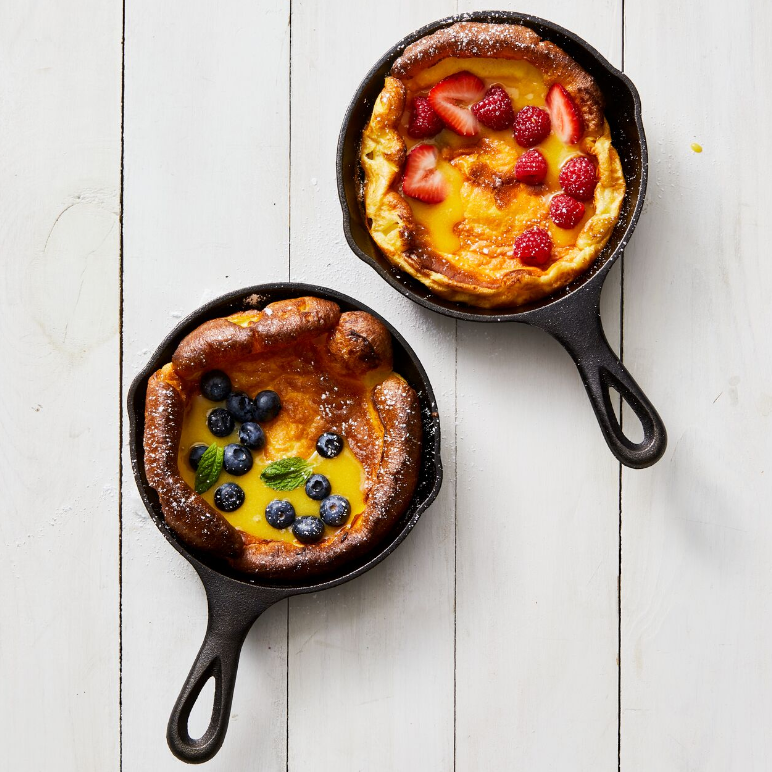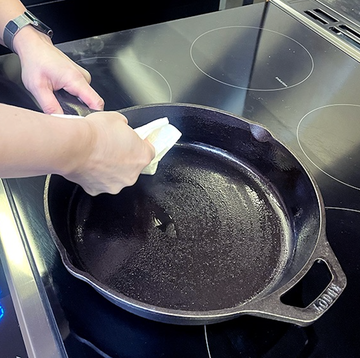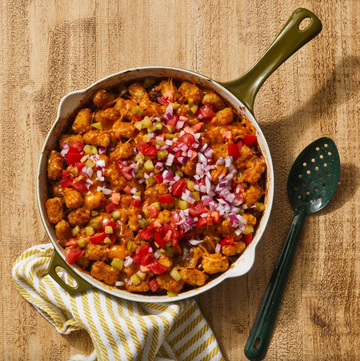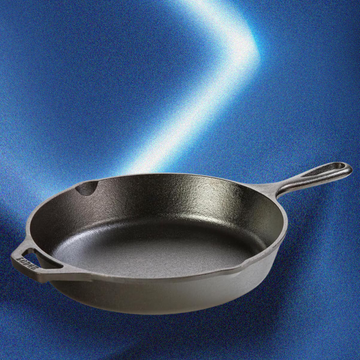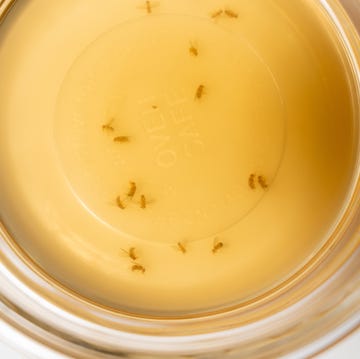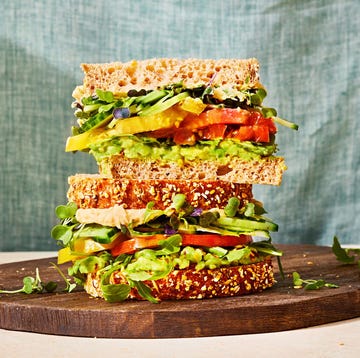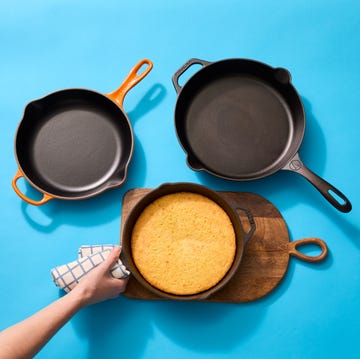Cleaning a cast iron skillet can feel intimidating — what if you strip away the seasoning? What if you ruin it forever? But skipping proper cleanup can lead to worse issues: sticky residue, stubborn buildup and even rancid flavors that cling to your food.
Keeping your cast iron clean is just as important as seasoning it. Doing so preserves the pan’s performance by making sure food bits and grease don't accumulate and cause hot spots and sticking. It also helps develop that coveted patina with every use.
The patina is what transforms raw cast iron into a reliable, nonstick workhorse. This deep, dark coating builds over time as fats polymerize during cooking. "Cooking lots of fatty food helps naturally season cast iron, like skin-on chicken thighs or bacon," says Nicole Papantoniou, director of the Good Housekeeping Institute's Kitchen Appliances and Innovation Lab. But it’s not magic — you’ve got to take care of your pan for it to take care of you.
Below, we break down two easy and effective methods for cleaning cast iron without ruining that precious seasoning: one using dish soap and one using coarse salt. Plus, we'll share how and when to reseason your skillet.
Want more cleaning tips? Sign up for Good Housekeeping's FREE cleaning newsletter!
What you'll need
- Dish soap
- Stiff bristled brush
- Paper towel or cleaning cloth
- Vegetable oil
How to clean a cast iron skillet after cooking
"Your cast iron skillet should be hand-washed after every use, but never leave cast iron soaking in water, and never put it in the dishwasher," says Carolyn Forté, executive director of the Good Housekeeping Institute Home Care and Cleaning Lab.
Still, there's no need to baby it. Just follow a few simple steps:
Step 1: Wash with warm suds.
Once the pan is cool enough to touch, wash it with warm water and a few drops of mild dish soap. Use a stiff-bristle dish brush to scrub gently. Avoid steel wool or scouring pads that can strip seasoning.
Step 2: Rinse and heat.
Rinse off the suds and return the skillet to the burner. Heat for 30 seconds or until dry.
Step 3: Coat with oil.
Using a paper towel, rub a small amount of vegetable oil into both the interior and exterior surfaces of the skillet. (You may also use a cleaning cloth or dish towel, but it may stain.)
Step 4: Air dry.
Once fully cool, place a paper towel or paper plate inside the pan to absorb residual moisture and oil before storing. Pro tip: Papantoniou lets her skillet rest on the counter overnight to ensure it's completely dry before storage.
How to clean a cast iron skillet with salt
Cleaning your cast iron with coarse salt is a good alternative to using dish soap, says Papantoniou. It helps preserve the patina and reduces the frequency of reseasoning the pan. When deciding which method to follow, it ultimately comes down to personal preference and the seasoning your pan has built up.
"I've been using my cast iron pan for over 10 years at this point," says Papantoniou. "I used to always clean it with salt, but now I can wash it with soap and water and rarely have to reseason it because it's seasoned so well over the years."
Step 1: Coat the skillet with salt.
Pour out any food bits or drippings from the pan and add a thin layer of kosher salt to the inside of the skillet.
Step 2: Scrape up food bits.
Use a wooden spatula to scrape away stuck-on food and burnt bits. Note: This process is best performed on the stovetop to prevent scratching the countertop. If bits are difficult to remove, heat the skillet slightly as you scrape to help loosen debris.
Step 3: Let cool.
Once completely cool, discard the salt and wipe the pan clean with a paper towel or a cleaning cloth.
How to remove rust from a cast iron skillet
Rust happens, but it doesn’t mean your pan is a goner. A regular cleaning (above) should be enough to bring a rusty cast iron skillet back to life, but you may need to switch your bristle brush for something a bit stronger, like a stainless steel chainmail scraper or heavy-duty scouring pad.
If your patina appears lackluster after removing the rust spots and drying the skillet, you may need to reseason it by following the steps below.
How often do you need to reseason a cast iron pan?
In most cases, regular cooking with oil will keep your cast iron skillet's patina in great shape, and you shouldn't ever need to reseason it in the oven. However, you may need to do a full reseasoning when restoring a rusty or damaged skillet (you'll notice food sticking or dull, patchy spots).
Step 1: Scrub the pan clean.
Follow the steps above for a regular cleaning, or whip out the heavy-duty tools to tackle rust.
Step 2: Oil the pan.
Dry it thoroughly over heat and use a paper towel to apply a thin coat of vegetable oil all over, including the outside and handle.
Step 3: Bake it.
Place the skillet upside down on an oven rack and bake at 450°F for one hour. Put a piece of foil on the lower rack to catch drips.
Step 4: Let cool.
Let the pan cool completely at room temperature before storing.
Why trust Good Housekeeping?
Nicole Papantoniou is the director of the Good Housekeeping Institute Kitchen Appliances and Innovation Lab. She has cared for several cast iron pans for more than a decade and stored one on her stovetop for years to ensure she never put it away damp.
Carolyn Forté is the director of the Good Housekeeping Institute Home Care and Cleaning Lab. She has over 40 years of experience testing cleaning methods, products, and appliances to find the picks that are worth your time and money.
Perry Santanachote is a contributing writer for Good Housekeeping. She has been testing and writing about the best kitchen appliances and cookware for over a decade. She has even more experience in the food industry, working as a recipe developer, food stylist and cook. That means she's scrubbed many dirty pans in her career!
Perry Santanachote (she/her) has more than 15 years of experience in service journalism, specializing in food and consumer goods. She tests and reports on kitchen appliances and cooking tools. She also evaluates food products and cleaning supplies. She’s an experienced writer, product tester and recipe developer who has worked in labs, test kitchens and media organizations, including Thrillist and Consumer Reports.
Nicole (she/her) is the director of the Good Housekeeping Institute's Kitchen Appliances and Innovation Lab, where she has overseen content and testing related to kitchen and cooking appliances, tools and gear since 2019. She’s an experienced product tester and recipe creator, trained in classic culinary arts and culinary nutrition. She has worked in test kitchens for small kitchen appliance brands and national magazines, including Family Circle and Ladies’ Home Journal.
Carolyn Forté brings more than 40 years of experience as a consumer products expert to her role as executive director of the Good Housekeeping Institute's Home Care and Cleaning Lab. Using deep analytical testing and writing expertise in appliances, cleaning, textiles and organizational products, she produces cleaning and home care advice for GH, has authored numerous books and bookazines for the brand and partners with the American Cleaning Institute to co-produce the Discover Cleaning Summits. She holds a bachelor's degree in family and consumer sciences from Queens College, City University of New York.

